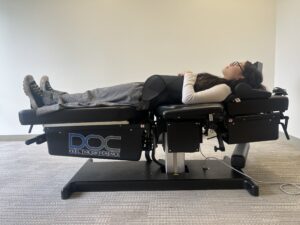This article will discuss shockwave therapy and how it cures plantar fasciitis. Shockwave therapy proves to be the best among the other options available to treat plantar fasciitis. So let’s understand those concepts and why this therapy is best.
What is Shockwave Therapy?
In this therapy, the sound waves or acoustic waves go deep into the muscle, tendon, or ligament. It is a non-invasive, outpatient alternative to surgery for people suffering from joint and tendon disorders.
Patients looking for an alternative to conventional treatments like orthotics and injections find this treatment very useful. For example, shockwave therapy helps people with tennis elbow, golfer’s elbow, knee pain, shoulder pain, and plantar fasciitis.
How does it work?
Shockwave therapy helps treat tennis elbow, heel pain, and degenerated tendons. After completion of diagnosis, the therapy starts with the probe. Firstly, your doctor will apply gel to the skin of the concerned area. Next, he will do a non-invasive probe to that part of the body.
An electric charge will create focused energy on the area of concern. These shock waves heal the tissues by creating force. After the session ends, your doctor will remove the gel from the skin.
To get to the root cause of pain and discomfort and experience the healing power of sound, schedule an initial consultation, including a comprehensive evaluation and first treatment.
Is Shockwave Therapy painful?
The main complication involved in this treatment is pain and hypersensitivity. These issues generally resolve with time. The active participation of the patient makes this treatment more successful.
High energy wave may require local anesthesia, as it causes some pain, whereas low energy wave therapy doesn’t require anesthesia. Pain and disability may persist if the treatment is not successful.
What is Plantar Fasciitis & where is the pain in plantar fasciitis located?
The plantar fascia is at the bottom of the foot. In this disorder, the inflammation takes place in the foot’s heel. The patient may feel a sharp pain in the morning or after long durations of activity.
To be precise, Plantar Fasciitis is the pain at the heel, specifically in the calcaneus bone. The patient may feel pain in the morning after the rest of the whole night. Also, the long walks or running sessions can cause pain in this area. Shockwave therapy treats plantar fasciitis.
- Around 4-7% of the population gets heel pain at a given time and 80% of these are because of plantar fasciitis.
- This disorder becomes more common with age.
What is the cause of plantar fasciitis? Who is affected by this disease?
Repeated stress and tension on the feet can cause inflammation in the plantar fascia. This results in plantar fasciitis. There is no particular reason for this disorder. But the following categories of people are more prone to plantar fasciitis-
- People between the age group of 40 to 60 years.
- Athletes and sportspersons who do more exercises which cause stress on heels.
- People with flat feet, a high arch, or a typical walking style can suffer from plantar fasciitis.
- Obesity causes stress on the feet. Hence those who are carrying extra weight are prone to this disorder.
- The people with occupations that keep them on their feet regularly for a long time.
Does obesity contribute to plantar fasciitis?
Obesity is one of the factors causing stress on the feet. A person who is carrying extra weight puts added pressure on the plantar fascia. The extra weight causes heal pain, which puts a load on joints and ligaments.
Consulting a doctor for suitable weight-loss methods and doing exercises regularly will help avoid the risk of plantar fasciitis in the case of people who are carrying extra weight.
Signs/symptoms of plantar fasciitis:
If you are suffering from one or more signs/symptoms present below, then there is a possibility that you have plantar fasciitis-
- Pains in the bottom and nearby area of the heel.
- Increasing pains after a workout.
- Pain in the arch of the foot can be a symptom.
- Worst pain in the morning and standing after sitting for a long duration.
- The swollen heel can also be a sign of plantar fasciitis.
- Continuing pain for months.
- 80% of people have reported tight Achilles as a symptom.
How can shockwave therapy cure plantar fasciitis?
If the conservative treatment options did not work in the early days, there were limited choices like steroid injections, custom orthotics, or invasive surgeries for plantar fasciitis. Unfortunately, these options cannot be used in the long term since they can weaken the tendon.
Shockwave therapy is a quick, gentle, non-surgical treatment option which helps reduce the pain from plantar fasciitis. Currently, this treatment is highly effective and the most advanced therapy available for plantar fasciitis.
In this process, the special probe delivers pressure to the concerned area and triggers the body’s self-healing process. This results in the formation of new blood vessels. Thus it is a very effective treatment.
You may also find these resources very helpful:
What are the home remedies to treat plantar fasciitis? (primary solution to treat the pain before visiting a chiropractor)
The majority of the people with plantar fasciitis recover within 10 months by following home remedies. They are:
- Stretching the calf muscles.
- Avoid walking bare feet. Use well-cushioned, sturdy and supportive shoes.
- Use arch supports, appropriate shoe inserts, or custom-made foot orthotics.
- For reducing tightness in the calf muscle, use a night splint.
- Massaging the affected area can also give relief.
- Apply ice on the area for 10 to 15 minutes, three to four times per day.
- Restrict physical activity along with prolonged standing.
- Take over-the-counter nonsteroidal anti-inflammatory drugs like ibuprofen or naproxen.
- Lose weight and use crutches.
What are the therapies for plantar fasciitis other than shockwave therapy?
The treatment options other than shockwave therapy are as follows:
Physical therapy- A therapist teaches exercises to the patient that requires stretching of plantar fascia and Achilles tendon to strengthen lower leg muscle.
Night splints- Wearing a splint can keep the plantar fascia and Achilles tendon in a stretched position overnight while the patient sleeps.
Orthotics- Using custom-fitted or off-the-shelf arch supports distributing the pressure on the feet more evenly.
Walking boots, crutches, or canes- Using one of these products for a longer duration as per recommendation from the health care provider.
Other procedures- If the above options do not give results, then the other options like steroid injection, surgery, and ultrasonic tissue repair can help to get relief.
Why is shockwave therapy better than other therapies?
We have seen options other than shockwave therapy for plantar fasciitis. They have their limitations as follows:
- Steroid injections cannot be used for a long time since they can weaken the tendon.
- Wearing a particular shoe for a long time for custom orthotics is not convenient.
- Invasive surgeries are risky because of the side effects and an extended downtime which is not favorable.
But in shockwave therapy, there is no risk, no inconvenience of wearing the particular shoe, and no injections are involved. Besides these factors, this therapy is quick, gentle, advanced, and highly effective. These features make it better than other therapies.
What are the side effects of plantar fasciitis?
Some effects may not be strictly known as side effects, but they are observed if the plantar fasciitis is left untreated. They are:
- Chronic heel pain hinders daily activities.
- The change in walking style to avoid pain can lead to hip, knee, foot, and back problems.
- Heel spurs, ligament tears, ankle pain, pelvic instability, osteoarthritis, etc.
- Plantar tears, plantar rupture, and plantar fibromatosis are some of the consequences.
How many shockwave therapy sessions are required to treat plantar fasciitis? How long does it take to cure this?
The number of sessions and duration required for treatment varies from person to person. It is also dependent on the intensity of the pain. But average, three to four weekly sessions/sittings are necessary for complete healing.
Some people start feeling relief immediately after the session, while others feel it 2 to 4 hours after the session. There is no downtime required. Patients can join back their routine activities after the sessions.
Exercises for plantar fasciitis:
We have already understood that this disorder requires rest and not significant activity. So there is no need for any rigorous exercises for this treatment. Only some stretching exercises are sufficient and helpful for relief. They are as follows-
- Calf stretches.
- Rolling stretches.
- Seated foot stretches.
- Towel curls.
- Marble pickups.
With the help of these exercises and proper rest, the patient will feel relief very soon.
Are you dealing with a sharp pain at the heel after a walk, running session, or early in the morning when you get out of bed? You are most probably suffering from Plantar Fasciitis. Shockwave therapy has a success rate of around 60-80%.
To get to the root cause of pain and discomfort and experience the healing power of sound, schedule an initial consultation, including a comprehensive evaluation and first treatment.



